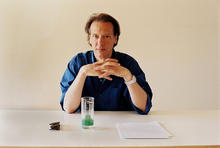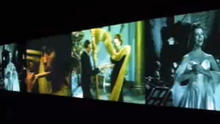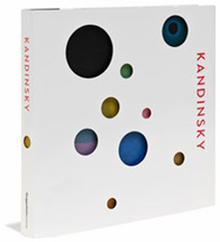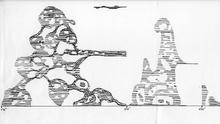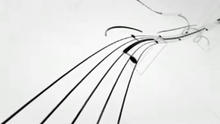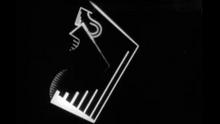Screenplay
(2005)is one of Christian Marclay's visual scores, in which found materials are collated as a representation of a sound performance to be interpreted by musicians.
Screenplay is compiled from film footage that Christian Marclay spliced into something of a narrative. In addition, he introduced simple, colorful digital animations of lines and waveforms and big, round dots on top of some of the footage. (...)
Marclay's art often has a magnetic quality, in which the world seems to conform itself to his mindset. For example, in the sequence depicted above, the actions of the conductor, which already were meant to give instruction to musicians, take on a whole new symbolic purpose.
There is a stream-of-consciousness quality to Christian Marclay's Screenplay. For example, at one point there's a chase scene that ends up with a door being locked, followed by a close-up of the lock, and then when the key falls out of the lock, something on the floor explodes, which leads to numerous sequences of ever more out-of-control fires, which then leads to scene after scene of water. Each of the segments of the silent, unfolding story is taken from a different pre-existing source, but through Marclay's editing, they're combined into something fluid and whole. As with the numerous printed scores on display, Screenplay is running unaccompanied by music – if Marclay uses art as score, in this setting his score is the art.
Source: disquiet
Artist/composer Christian Marclay (b. 1955) is known for his distinctive fusion of image and sound. Celebrated as a pioneer of turntablism, Marclay transforms sound and music into visual and physical forms through performance, collage, sculpture, large-scale installations, photography, and video. This groundbreaking Whitney exhibition—activated by daily concerts and continually evolving—explores Marclay’s approach to the world around him with a particular focus on his “graphic scores” for performance by musicians and vocalists. Visitors to the Whitney will be encouraged to mark up a wall-sized chalkboard, with musical staff lines, thereby creating a collective musical score which will be performed throughout the run of the show. Other Marclay scores, including the premiere of a new scrolled vocal work forty feet in length and three scores conceived as projections, will be continually on view and performed on a regular basis. World renowned musicians and vocalists, some of whom have been regular collaborators with the artist for three decades, will interpret a dozen scores, enabling museum audiences to experience a less well known aspect of Marclay’s varied art practice.
Source: Whitney Museum


